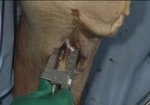Playback speed
10 seconds
"Precision Technique" of Preoperative Planning for Tibial Slope Correction Osteotomy
0 views
June 14, 2024
Identification of posterior tibial slope and slope correction osteotomies have lately gained importance in various ...
read more ↘ knee surgeries. The preferred surgical methods have been a flexion (opening) / extension (closing) wedge osteotomy at the proximal tibia.
Current methods of tibial slope measurements use the anterior tibial cortical line (ATL), posterior tibial cortical line (PTL) or the anatomical axis of tibia (AAT) on a short lateral view X-ray of tibia. This can have a high inter and intra-observer variability.
Measuring the tibial slope using ‘mechanical axis’ has potentially less inter and intra-observer error. But simply using the difference between preoperative and planned postoperative tibial slope measures as the osteotomy correction angle (OCA), with the reference line as ‘mechanical axis’ gives erroneous correction.
The ”Precision technique” is devised to calculate the OCA with least errors using ‘mechanical axis’ as the reference line. This technique minimises errors in preoperative planning. This can further translate into better clinical results due to reduction in preoperative planning errors.
Principles of this technique can also be used to plan other osteotomies for angular corrections of long bones where the joint line / slope / alignment is to be corrected with reference to the mechanical axis
Link to published open access article -
https://jassm.org/a-novel-precision-technique-for-preoperative-planning-of-posterior-tibial-slope-correction-osteotomy/
↖ read less
read more ↘ knee surgeries. The preferred surgical methods have been a flexion (opening) / extension (closing) wedge osteotomy at the proximal tibia.
Current methods of tibial slope measurements use the anterior tibial cortical line (ATL), posterior tibial cortical line (PTL) or the anatomical axis of tibia (AAT) on a short lateral view X-ray of tibia. This can have a high inter and intra-observer variability.
Measuring the tibial slope using ‘mechanical axis’ has potentially less inter and intra-observer error. But simply using the difference between preoperative and planned postoperative tibial slope measures as the osteotomy correction angle (OCA), with the reference line as ‘mechanical axis’ gives erroneous correction.
The ”Precision technique” is devised to calculate the OCA with least errors using ‘mechanical axis’ as the reference line. This technique minimises errors in preoperative planning. This can further translate into better clinical results due to reduction in preoperative planning errors.
Principles of this technique can also be used to plan other osteotomies for angular corrections of long bones where the joint line / slope / alignment is to be corrected with reference to the mechanical axis
Link to published open access article -
https://jassm.org/a-novel-precision-technique-for-preoperative-planning-of-posterior-tibial-slope-correction-osteotomy/
↖ read less
Comments 3
Login to view comments.
Click here to Login




















